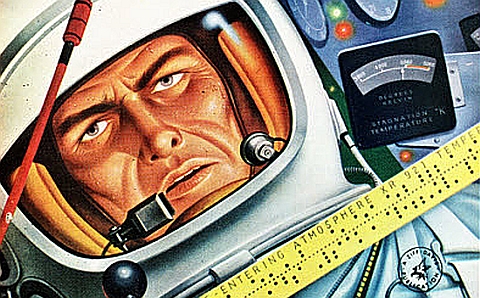Cele Goldsmith and the Ultimate AMAZING
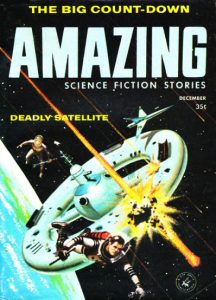 When Paul Fairman left in 1958, Ziff-Davis could easily have suspended publication of AMAZING STORIES and FANTASTIC, or sold the magazines to the highest bidder. Since the departure of publisher Bernard Davis the year before, the company had oriented itself in favor of the slick market with POPULAR PHOTOGRAPHY and CAR AND DRIVER, and had little interest in the pulp fiction field. As long as the magazines made a profit they were left alone, but were not considered worthy of further investment.
When Paul Fairman left in 1958, Ziff-Davis could easily have suspended publication of AMAZING STORIES and FANTASTIC, or sold the magazines to the highest bidder. Since the departure of publisher Bernard Davis the year before, the company had oriented itself in favor of the slick market with POPULAR PHOTOGRAPHY and CAR AND DRIVER, and had little interest in the pulp fiction field. As long as the magazines made a profit they were left alone, but were not considered worthy of further investment.
It was in this backwater scenario that Cele Goldsmith found herself. She had joined Ziff-Davis as secretary and all-around assistant to Howard Browne in 1955, and had continued to assist Fairman during his editorship. Fairman was content for Goldsmith to do most of the first selection of unsolicited manuscripts, while he dealt with the regular contributors. By the time he left, she had gained sufficient editorial experience to take over. Perhaps Ziff-Davis had some concern about her ability to work totally alone, since the company brought in Norman Lobsenz as editorial consultant. “Norm and I had a fabulous working arrangement,” Cele told me when we corresponded in 1982. “Without him I would have been in total isolation.”
Goldsmith chose all the material, edited everything, selected the title and blurb typefaces and dummied the monthly magazines by herself. Lobsenz, who arrived for an editorial conference usually once a week, penned the editorials, read her choices, and wrote the blurbs for the stories. They did cover blurbs together, and Goldsmith assigned both interior and cover art.
Goldsmith had no scientific background but had a sound judgment of story content and development, and this was the key to her success. She accepted stories on their value as fiction rather than as science fiction. “When I read something I didn’t understand, but intuitively knew was good,” she said, “I’d get ‘goose flesh’ and never doubt we had a winner.” That “goose flesh” was transmitted to the readers. I know when I encountered the Goldsmith AMAZING and FANTASTIC in the early 1960s, I got goose flesh because of the power and originality of their content. As I look now at the 150 or more total issues of those two magazines that Cele Goldsmith edited, that thrill is still there.
The change was noticeable almost immediately. For a start, all of the old house pseudonyms vanished. The authors behind the names — Silverberg, Slesar, Ellison, and Garrett — continued to appear, but with more original, non-formula stories.
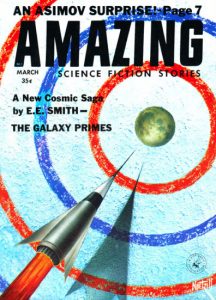 Goldsmith regards the March 1959 issue of AMAZING as the first to reflect the steps she wished to take. That magazine featured a new cover artist, Albert Nuetzell. Cover art was to become a distinct feature of Goldsmith’s tenure. Under Fairman and in the later days of Howard Browne’s editorship, the covers had been left chiefly to Ed Valigursky, a competent artist but one who let B-movie action and imagery override originality and artistic value. Almost all of the Goldsmith-era covers, on the other hand, are of artistic merit. Her mainstay artists were Alex Schomburg, Ed Emshwiller, George Schelling, and Lloyd Birmingham. There are also some striking covers by Robert Adragna and Gray Morrow, and even one by Virgil Finlay.
Goldsmith regards the March 1959 issue of AMAZING as the first to reflect the steps she wished to take. That magazine featured a new cover artist, Albert Nuetzell. Cover art was to become a distinct feature of Goldsmith’s tenure. Under Fairman and in the later days of Howard Browne’s editorship, the covers had been left chiefly to Ed Valigursky, a competent artist but one who let B-movie action and imagery override originality and artistic value. Almost all of the Goldsmith-era covers, on the other hand, are of artistic merit. Her mainstay artists were Alex Schomburg, Ed Emshwiller, George Schelling, and Lloyd Birmingham. There are also some striking covers by Robert Adragna and Gray Morrow, and even one by Virgil Finlay.
The next distinctive feature of that issue was the beginning of a new serial by E. E. (Doc) Smith, “The Galaxy Primes.” It was a delight to see Smith back in AMAZING, the magazine through which he had opened the field to the super-science revolution with “The Skylark of Space” in 1928. His new novel, which received a mixed reaction at the time, is an ebullient blend of higher mathematics, mental powers, and planetary adventure.
The presence of Smith in this issue was symbolic. It was both a link to the groundbreaking origins of AMAZING, and an announcement that the next revolution was about to take place. By providing that feeling of continuity, Goldsmith had succeeded in breaking from the old mold into the new without dispossessing readers, which is what had happened when Howard Browne had tried to upgrade AMAZING from its old pulp image in 1953.
This approach was echoed in the magazine’s third feature. Goldsmith had commissioned a new story from Isaac Asimov, “Anniversary,” to celebrate the twentieth anniversary of Asimov’s first appearance in print with “Marooned Off Vesta” in the March 1939 issue of AMAZING. The two stories were published together in the March 1959 magazine.
Readers were very positive in their reaction to the changes, and Goldsmith pledged more. Her work over the next few years can best be summarized by saying that she encouraged both the old and the new writers to try something different. She was always prompt in her response to a submission, which resulted in Piers Anthony calling her “fast and good” when he wrote about her in his BIO OF AN OGRE (Ace, 1988). The result of her efforts was a magazine that developed some of the newest talent around in the field, and brought an excitement to the genre that had been missing for much of the 1950s.
Cele Goldsmith’s first major discovery was Keith Laumer, whose “Greylorn” was published in April 1959. Laumer was stationed with the U. S. diplomatic corps in India, and his brother had brought the story into the Ziff-Davis offices, requesting to see the editor and interrupting her work. She was annoyed and almost rejected the manuscript there and then, but upon reading it she was captured by Laumer’s humor and perception. Soon afterward, she bought the first of Laumer’s Retief stories, “Diplomat at Arms,” which ran in the January 1960 FANTASTIC.
April 1959 also featured the publication of a Cordwainer Smith story, “Golden the Ship Was — Oh! Oh! Oh!” Smith’s idiosyncratic style made him a unique talent, and his appearance in AMAZING was further proof of the magazine’s break with the past, and of Goldsmith’s determination to be fresh and exciting.
The May 1959 issue included “Initiative” by Boris and Arkady Strugatski, hailed in the blurb as the first Soviet sf story translated for American readers. That wasn’t quite true, since Hugo Gernsback had reprinted V. Orlovsky’s “Revolt of the Atoms” in AMAZING thirty years earlier; but nothing of the sort had happened since, so it was appropriate that it was AMAZING that started the Soviet and U. S. link again. Shortly afterward, interest began to climb in Soviet sf writing, and the Strugatski brothers became the most notable among many talented writers from the Soviet Union.
“The Stars Are Calling, Mr. Keats” (June 1959) was a poignant story of a spaceman’s relationship with an extra-terrestrial bird, which is all that stands between him and loneliness. The author, Robert F. Young, had appeared in a variety of magazines during the 1950s, but he now became a regular in AMAZING and FANTASTIC through the first half of the 1960s with a special kind of story that put the human perspective at the forefront. Other nomadic authors who now found a home in AMAZING and FANTASTIC were Arthur Porges, Daniel F. Galouye, H. Beam Piper, and Ron Goulart.
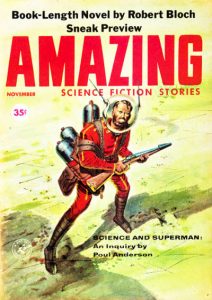 Perhaps the most enigmatic was David R. Bunch, whose bizarre stories typify the uniqueness of the Goldsmith years. “The Flesh-Man from Far Wide” (November 1959) was the first of Bunch’s Moderan stories, depicting a world where man was almost machine. Bunch used this concept to contrast the human and technological interrelationship. The Bunch stories, possibly more than anyone else’s, presaged the “new wave” that was to hit science fiction in the mid-1960s.
Perhaps the most enigmatic was David R. Bunch, whose bizarre stories typify the uniqueness of the Goldsmith years. “The Flesh-Man from Far Wide” (November 1959) was the first of Bunch’s Moderan stories, depicting a world where man was almost machine. Bunch used this concept to contrast the human and technological interrelationship. The Bunch stories, possibly more than anyone else’s, presaged the “new wave” that was to hit science fiction in the mid-1960s.
It is difficult during this period to keep FANTASTIC separate from AMAZING. While FANTASTIC tended to publish the more surreal, off-trail stories, it also published science fiction and sometimes acted as a repository for overflow from AMAZING and as a forum to experiment. Frequently Goldsmith’s discoveries first appeared in FANTASTIC before graduating to AMAZING. One such discovery was Jack Sharkey, who had been a novice writer in New York, struggling to sell his first story, when Goldsmith bought “The Arm of Enmord” just before Christmas 1958. She was impressed with Sharkey’s work and ran two stories in the March 1959 FANTASTIC, giving him a double debut. The stories were of contrasting types — one humorous, one dramatic — and Goldsmith asked readers which they preferred. In fact they liked both, though it was humor with which Sharkey became most associated over the next six years.
One of the experiments with FANTASTIC was to devote the November 1959 issue to the work of Fritz Leiber, presenting five new stories. Leiber was making a comeback into the sf field, after a period when his descent into alcoholism had seriously endangered his writing. This special presentation gave him the boost he needed. It also gave a new lease on life to those two other-world rascals, Fafhrd and the Gray Mouser. Starting with “Lean Times in Lankhmar,” the first piece presented in the special Leiber issue, their adventures became a regular feature of FANTASTIC over th next few years.
All of the above developments took place in Cele Goldsmith’s first year as editor. Her second year was almost as dramatic.
“Transient” by Ward Moore was the lead short novel in the February 1960 AMAZING. This story brought a large-scale response because of the casual sex in the story (mild by today’s standards) and because the story was more fantasy than sf. That didn’t matter. What was significant was that the issue could provoke such a reaction. This showed that AMAZING had harnessed a loyal and vociferous readership. One such vocal reader was F. M. Busby, then a leading fan, who subsequently has become an irreverent and irregular author of note. He found Moore’s story a “most striking piece of work,” adding “I’m not surprised that ‘Transient’ was a bit too rich for the blood of several readers; it is pretty far out.” In his letter published in the August 1960 issue, Busby went on to sum up the recent past history of AMAZING in a few caustic words: “After Palmer’s screwballisms, Browne’s well-meant ignorance of the field, and Fairman’s utter dedication to printing crud (even if he had to write it himself to avoid printing something readable) your regime still seems a bit unbelievable to the long-time reader.”
Cele Goldsmith was striking to the core.
More new writers began to appear. That same February 1960 issue offered “A Long Way Back,” Ben Bova’s first published story. Bova would later become editor of ANALOG and then editor of OMNI, and for a period became a regular contributor of scientific articles to AMAZING. The August 1960 issue contained the first appearance of Neal Barrett, Jr., with “Made in Archerius.” Curiously, Barrett’s stories, of which there were five in AMAZING and FANTASTIC at this time, made little impact, but in recent years he has started to acquire a cult status for his original and offbeat novels, and those early stories are worthy of reconsideration.
Goldsmith also established a regular nonfiction feature in AMAZING. One might measure this from “Stargazers,” a controversial attack on astronomers by Eric Frank Russell in the January 1959 issue, although this article had been an outgrowth of a series Russell had written for FANTASTIC on strange phenomena. The new series of nonfiction features really started with “The Unused Stars” by Isaac Asimov (July 1959), and thereafter noted sf writers contributed articles about topics in science and science fiction. Meanwhile, in FANTASTIC, Sam Moskowitz began his series of profiles of leading sf and fantasy writers, starting in the May 1960 issue with a study of H. P. Lovecraft. This series later switched to AMAZING with a profile of Hugo Gernsback in the September 1960 issue. Almost all of the articles that were later collected in Moskowitz’s SEEKERS OF TOMORROW (World, 1966) first appeared here.
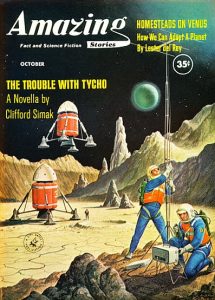 The transition from the old to the new concluded with the October 1960 AMAZING. This issue featured a new title logo, which was more vibrant than the 1950s bold type, and an enticing cover painting by Alex Schomburg illustrating Clifford Simak’s “The Trouble With Tycho.” Schomburg became a regular cover artist for AMAZING and FANTASTIC, often with bold and original concepts, and in 1962 he was nominated for a Hugo Award as Best Professional Artist. The contents of that October 1960 issue were not significantly different, but the image had changed, and the new-style AMAZING was now firmly entrenched.
The transition from the old to the new concluded with the October 1960 AMAZING. This issue featured a new title logo, which was more vibrant than the 1950s bold type, and an enticing cover painting by Alex Schomburg illustrating Clifford Simak’s “The Trouble With Tycho.” Schomburg became a regular cover artist for AMAZING and FANTASTIC, often with bold and original concepts, and in 1962 he was nominated for a Hugo Award as Best Professional Artist. The contents of that October 1960 issue were not significantly different, but the image had changed, and the new-style AMAZING was now firmly entrenched.
In his editorial in the October 1960 AMAZING, Lobsenz bemoaned the lack of quality sf. Despite Cele’s efforts to find good new stories, they were not always there. Consequently the editors introduced a policy of classic reprints, commissioning Sam Moskowitz to select stories from AMAZING‘s archives. These were restricted to one an issue, and Moskowitz’s selections were always of high quality. They started with “The Lost Machine” by John Beynon Harris (John Wyndham], one of his best early stories. At a time when pre-Golden Age stories (pre-1938, when John W. Campbell took over at ASTOUNDING) were seldom reprinted, these came as a revelation to many. The April 1961 issue was given over entirely to reprint stories, plus a guest editorial by Hugo Gernsback, to mark the magazine’s thirty-fifth birthday. That issue also included Frank R. Paul’s last original painting for the magazine.
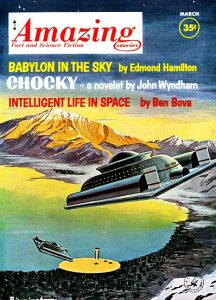 It is difficult to single out all the stories of lasting merit that appeared in AMAZING during the golden Goldsmith years. A few by established authors of the day may provide a taste: “Before Eden” by Arthur C. Clarke (June 1961), “Tongues of the Moon” by Philip José Farmer (September 1961), “Third Stage” by Poul Anderson (February 1962), “The Thousand Dreams of Stellavista” by J. G. Ballard (March 1962), “The Stars, My Brothers” by Edmond Hamilton (May 1962), “Chocky” by John Wyndham (March 1963), “Drunkboat” by Cordwainer Smith (October 1963), and “The Days of Perky Pat” by Philip K. Dick (December 1963), which formed the basis of his novel THE THREE STIGMATA OF PALMER ELDRITCH (Doubleday, 1965). AMAZING also gave first publication to a previously unprinted story by Edgar Rice Burroughs, “Savage Pellucidar” (November 1963), which became a Hugo Award nominee.
It is difficult to single out all the stories of lasting merit that appeared in AMAZING during the golden Goldsmith years. A few by established authors of the day may provide a taste: “Before Eden” by Arthur C. Clarke (June 1961), “Tongues of the Moon” by Philip José Farmer (September 1961), “Third Stage” by Poul Anderson (February 1962), “The Thousand Dreams of Stellavista” by J. G. Ballard (March 1962), “The Stars, My Brothers” by Edmond Hamilton (May 1962), “Chocky” by John Wyndham (March 1963), “Drunkboat” by Cordwainer Smith (October 1963), and “The Days of Perky Pat” by Philip K. Dick (December 1963), which formed the basis of his novel THE THREE STIGMATA OF PALMER ELDRITCH (Doubleday, 1965). AMAZING also gave first publication to a previously unprinted story by Edgar Rice Burroughs, “Savage Pellucidar” (November 1963), which became a Hugo Award nominee.
But despite the quality of these stories, it was not them that gave the goose flesh to readers. That excitement and anticipation came from the new writers who were emerging, who were bringing bold new ideas to sf and challenging old concepts. It was this aspect of her work that gave Cele the biggest thrill.
Of the authors who debuted in the middle period of Goldsmith’s editorship, four stand out: Roger Zelazny, Thomas M. Disch, Ursula K. Le Guin, and Piers Anthony. There is little doubt that science fiction owes a debt to Cele Goldsmith for putting these writers on the road. All of them had already tried to sell professionally — Le Guin had submitted a story to AMAZING as far back as 1939 — but none of them had found an editor appreciative of their talents. Only Goldsmith saw through the fantastic trimmings to the creative core, and her feedback gave the authors a respectability and encouragement. Although Anthony received only $20 for his first story, “Possible to Rue” (FANTASTIC, April 1963), he summed up the feeling of all authors with their first sale when he wrote in his autobiography that “the significance extended far beyond the money. I had made it!”
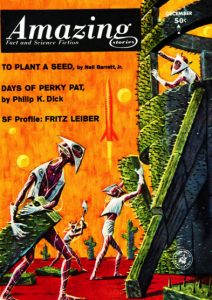 Zelazny sold twenty-three stories to Cele Goldsmith, of which “He Who Shapes” (January-February 1965) went on to win the first Nebula Award (presented by the newly formed Science Fiction Writers of America) for the year’s best novella. All of his stories were refreshingly different, pushing back the boundaries of sf. Among them are “The Graveyard Heart” and “The Furies,” now considered among sixties masterpieces of the outré, and his stories about Dilvish the Damned. All of these appeared in that cauldron of the bizarre, FANTASTIC.
Zelazny sold twenty-three stories to Cele Goldsmith, of which “He Who Shapes” (January-February 1965) went on to win the first Nebula Award (presented by the newly formed Science Fiction Writers of America) for the year’s best novella. All of his stories were refreshingly different, pushing back the boundaries of sf. Among them are “The Graveyard Heart” and “The Furies,” now considered among sixties masterpieces of the outré, and his stories about Dilvish the Damned. All of these appeared in that cauldron of the bizarre, FANTASTIC.
Cele Goldsmith’s efforts were recognized by the fans voting for the annual Hugo Awards. In 1960 AMAZING was nominated for the first time in the Best Professional Magazine category (though it lost out to F&SF). It was on the ballot again in 1961, 1962, 1964, and 1965, and FANTASTIC was nominated in 1963. Unfortunately, neither magazine ever won the award, but in 1962 the committee gave a special award to Cele Goldsmith for “the continued and consistent improvement, both visually and qualitatively, in the magazines which she edits.” She was the first sf magazine editor to be specifically recognized.
Alas, all Golden Ages come to an end. Despite a further facelift in January 1964, which gave AMAZING a more strident logo, the quality of the magazine’s content started to decline. In retrospect one might argue that the lead AMAZING had taken was now being imitated by rival magazines — especially IF in the United States, under Frederik Pohl, and NEW WORLDS in England, under Michael Moorcock — and this was draining the special qualities away from AMAZING. I’m not convinced that was the case. AMAZING was still finding fresh talent, including Norman Spinrad, Walter F. Moudy, Robert H. Rohrer, and Leo P. Kelley, and there were still plenty of good stories. The sparkle only vanished in the final few issues when the fate of the magazine was known.
By 1964 Ziff-Davis had completed its plans for expansion into the slick market, and AMAZING and FANTASTIC did not figure in those plans; Z-D wanted more hi-fl than sci-fi. AMAZING‘s circulation had dropped from 52,000 in 1962 to 35,000 in 1964, and the publisher called it a day. Ziff-Davis looked around for a purchaser, and in March 1965 the titles were sold to Sol Cohen, at that time the publisher of GALAXY and IF.
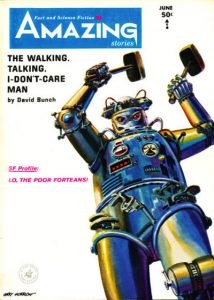 Cele Goldsmith Lalli (she had married in 1964) chose not to go with the magazines, and moved onto the editorial staff of MODERN BRIDE (she became its editor in 1982). Her last issue was for June 1965. There were no farewells or goodbyes. After nearly seven years as editor, and the best one AMAZING had had — indeed, one of the best magazine editors the field has seen — Cele Lalli moved on. And after twenty-seven years as AMAZING‘s publisher, Ziff-Davis parted company without a single eulogy.
Cele Goldsmith Lalli (she had married in 1964) chose not to go with the magazines, and moved onto the editorial staff of MODERN BRIDE (she became its editor in 1982). Her last issue was for June 1965. There were no farewells or goodbyes. After nearly seven years as editor, and the best one AMAZING had had — indeed, one of the best magazine editors the field has seen — Cele Lalli moved on. And after twenty-seven years as AMAZING‘s publisher, Ziff-Davis parted company without a single eulogy.
In buying the magazines, Cohen established a new company called Ultimate Publishing. His partner was Arthur Bernhard; however, Bernhard had nothing to do with the production side. Cohen kept this as his specialty, though he brought in as editor Joseph Wrzos (who anglicized his name to Ross to avoid any spelling errors). Wrzos was an English teacher who had worked for a short period as an assistant at Gnome Press in the 1950s. He had met Cohen by chance when he called at the GALAXY offices in late March 1965 to pick up an advance copy of the June issue. Cohen had been impressed that anyone should come from New Jersey for that reason, and he was further impressed by Wrzos’s knowledge of the field. A few weeks later Wrzos received a phone call from Cohen offering him the editorship of Cohen’s two new magazines.
It was Cohen’s belief that the only way to make the magazines profitable was to instigate a reprint policy. With the sale, Cohen had acquired all the rights to the stories purchased by Ziff-Davis. This included second serial rights, meaning that a story could be reprinted in the magazine without further payment to the author. There was nothing untoward about this procedure in the old pulp days, when authors seldom expected a story to be reprinted and preferred the money up front. Cohen thus sought to convert both AMAZING and FANTASTIC into all-reprint magazines. Wrzos talked him out of this, arguing that to attract readers the magazines should run at least one new story per issue. This wasn’t difficult to do at the start, since Cohen had the remaining stories in the Ziff-Davis inventory. Moreover, with a free range over AMAZING‘s forty years’ worth of material, Wrzos had a huge selection of good stories to pick from.
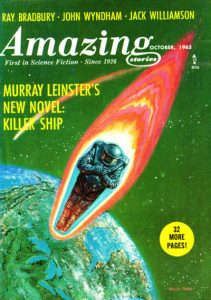 The first year of the Ultimate AMAZING was consequently not at all bad, and circulation did rise to nearly 50,000. New stories included “On the Sand Planet” by Cordwainer Smith, Murray Leinster’s novel “Killer Ship,” Philip K. Dick’s “Your Appointment Will Be Yesterday,” and Roger Zelazny’s “For a Breath I Tarry” (in FANTASTIC). The reprints were also worthy of resurrection, though here Cohen entered dangerous territory.
The first year of the Ultimate AMAZING was consequently not at all bad, and circulation did rise to nearly 50,000. New stories included “On the Sand Planet” by Cordwainer Smith, Murray Leinster’s novel “Killer Ship,” Philip K. Dick’s “Your Appointment Will Be Yesterday,” and Roger Zelazny’s “For a Breath I Tarry” (in FANTASTIC). The reprints were also worthy of resurrection, though here Cohen entered dangerous territory.
Perhaps it wasn’t too bad when the stories reprinted were early tales by writers long dead or forgotten. But when the selections were of more recent vintage, with the writers still active, they began to look askance at Cohen’s practices. Whether or not he was legally right, reprinting stories by authors without any payment was not an accepted practice, and certainly one that was frowned upon by the Science Fiction Writers of America (SFWA), then under the presidency of Damon Knight.
Cohen compounded the problem, however, not only by continuing with the reprints in AMAZING and FANTASTIC, but by starting a series of new magazines that consisted entirely of reprints and for which not a single payment was made. The first of these was GREAT SCIENCE FICTION, which went on sale in October 1965, followed by THE MOST THRILLING SCIENCE FICTION EVER TOLD (in April 1966) and by SCIENCE FICTION CLASSICS (in April 1967). This last title came under a new imprint that Cohen set up pseudonymously, and he brought in Herb Lehrman to help in the selection of reprints. (None of the editors of AMAZING and FANTASTIC during this time had anything to do with the production of the all-reprint magazines.) This move only antagonized SFWA all the more, and when Cohen refused to pay even token reprint fees to the authors, SFWA declared a boycott of the magazines and undertook legal proceedings against Cohen.
This battle went on for many months and brought a sour taste to the sf magazine world. After two years, Joseph Wrzos believed he had done all he could for the magazines, and had exhausted what he felt to be the best of the old material without transgressing into the realms of SFWA authors. Wrzos resigned in the summer of 1967 (his last issue being the November FANTASTIC).
Despite his brief tenure, Wrzos had served more than adequately as an editor in difficult circumstances, and the magazines had benefited from his love for the field. He had succeeded in buying some fine serials and novelettes including, in his second year, “Ensign Flandry” by Poul Anderson, “Born Under Mars” by John Brunner, “The Heaven Makers” by Frank Herbert, and Jack Vance’s “The Man From Zodiac.” But because most of these stories either came out as novels shortly after their magazine appearances, or were soon included in authors’ collections, they are not remembered for their magazine publication, and AMAZING is only remembered as a reprint magazine — and that almost as a mark of disdain. Yet other reprint magazines, from FAMOUS FANTASTIC MYSTERIES to MAGAZINE OF HORROR (which didn’t pay for reprint rights either) are remembered with fond nostalgia. Such is history.
If we are to put the record straight here, then we may look down upon GREAT SF and MOST THRILLING SF (and the score of other low-budget titles that Cohen released) because of the non-payment policy, and because of the quality of some of the fiction that was reprinted (most selections coming from the Palmer years). But if we are honest about AMAZING and FANTASTIC, those issues were of as reasonable quality as possible in the circumstances.
It was sobering that at the time of this unfortunate episode the magazine’s founder, Hugo Gernsback, died at the age of 83 on August 19, 1967. He must have looked with sadness upon the fate of his revolutionary brainchild.
The year after Wrzos’s departure was one of rapid change. He was succeeded by Harry Harrison. As an author, Harrison has maintained an enviable reputation for his action-packed sf (such as the DEATHWORLD series) and for his humorous satires about the Stainless Steel Rat. He had known Cohen since the early 1950s, and more recently had helped work out an interim agreement with SFWA. He had also been reviewing books for AMAZING for the last few issues. When Cohen asked if he would help edit the magazines, Harrison agreed on the condition that all reprints be phased out within a year.
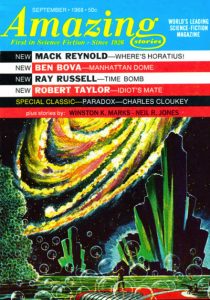 Harrison’s tenure was too brief to identify a discernible editorial trend. He sought to secure an international flavor for the magazine, printing a new Russian story, “An Unusual Case” by Gennadiy Gor, and introducing a featured “letter” from foreign lands — somehow, Brian Aldiss managed to contribute both a London letter and an Oslo letter. But Harrison left little mark on the fiction. Perhaps his most notable new story was Samuel Delany’s “House A-Fire” (an excerpt from his novel NOVA), but history may consider his most important story as being “A Darkness in My Soul” by Dean R. Koontz in the January 1968 FANTASTIC. In truth, though, this story — one of Koontz’s earliest and best — had been purchased by Wrzos. The most popular story Harrison published was almost certainly “Idiot’s Mate” by Robert Taylor, which was the only AMAZING story from the second half of the 1960s to be nominated for a Hugo. It considers man’s inhumanity to man in a real-life chess match played to the death on the Moon.
Harrison’s tenure was too brief to identify a discernible editorial trend. He sought to secure an international flavor for the magazine, printing a new Russian story, “An Unusual Case” by Gennadiy Gor, and introducing a featured “letter” from foreign lands — somehow, Brian Aldiss managed to contribute both a London letter and an Oslo letter. But Harrison left little mark on the fiction. Perhaps his most notable new story was Samuel Delany’s “House A-Fire” (an excerpt from his novel NOVA), but history may consider his most important story as being “A Darkness in My Soul” by Dean R. Koontz in the January 1968 FANTASTIC. In truth, though, this story — one of Koontz’s earliest and best — had been purchased by Wrzos. The most popular story Harrison published was almost certainly “Idiot’s Mate” by Robert Taylor, which was the only AMAZING story from the second half of the 1960s to be nominated for a Hugo. It considers man’s inhumanity to man in a real-life chess match played to the death on the Moon.
Harrison’s editorials suggest that he would have developed a blend between the emerging “new wave” fiction and the best of the pulp tradition, but none of this came about.
Five months after Harrison arrived he left, unable to persuade Cohen to drop the reprints. Harrison recommended Barry Malzberg, whom Cohen knew from his work at a literary agency. Malzberg started work on April 1, 1968, and resigned on October 19. In that period he compiled three issues each of AMAZING and FANTASTIC using stories purchased, for the most part, by Harrison. The January 1969 AMAZING is probably the closest to an all-Malzberg issue. It included the start of Richard C. Meredith’s powerful novel “We All Died at Breakaway Station” and a Dean Koontz story, “Temple of Sorrow.” It is interesting to note in Malzberg’s blurb for the story that he speculated on “just how good Mr. Koontz is going to be.”
In this issue Malzberg also contributed his only editorial to the magazine. Here, in his characteristically acerbic style, he claimed that most magazine sf was “ill-written, ill-characterized, ill-conceived and so excruciatingly dull as to make me question the ability of the writers to stay awake during its composition . . .” Malzberg contended that science fiction had to break with its tradition and establish itself as part of the mainstream of literature, albeit an eclectic element. Malzberg’s idea of radical writers included R. A. Lafferty, John Sladek, Thomas Disch, and David Bunch, whose stories he purchased. But Malzberg was not able to develop his plans. He fell out with Cohen over a cover that Malzberg had been authorized to commission but which Cohen refused to pay for.
In the background at this time, Robert Silverberg, who had become the new president of SFWA, had been seeking to achieve an amicable agreement between the organization and Cohen. It was not easy because of Cohen’s steadfast refusal to pay for reprints, and his insistence upon their use. Eventually, with patient coaxing, Silverberg reached a partly workable agreement. In appreciation, Malzberg credited him as Associate Editor of the magazine, though he had no real involvement with it other than writing a few guest editorials and articles. In the summer of 1968 Cohen told Silverberg that Malzberg was about to resign and asked if Silverberg had any idea for a successor. Silverberg recommended Ted White, who was promptly hired. Silverberg subsequently learned that Malzberg had not at that time intended to resign, and Cohen had used the opportunity of finding a new editor to fire Malzberg.
It was all unsavory and distasteful, and this period of AMAZING has to be among the lowest in terms of its publishing morals, even though it was not its lowest in story content.
But with the arrival of Ted White on the scene, all of that was about to change. Cohen at last met his match, and White was to usher AMAZING STORIES into a silver, if not a golden, age. We’ll look at his impact on the magazine on Monday, March 7th.
“The AMAZING Story: The Sixties — The Goose-Flesh Factor” is © 2016 by Mike Ashley and appears here with the author’s permission. Notes in italics are by PulpFest and are © 2016 by PulpFest. The original article was published by TSR, Inc. and edited by Kim Mohan for the May 1992 issue of AMAZING STORIES. Many thanks to Curt Phillips, the moderator of the Yahoo newsgroup PulpMags, for drawing our attention to and providing us with copies of Mike Ashley’s exceptional series of articles about the world’s first science-fiction magazine. Please visit pulpcon.org on Monday, March 7th, for the sixth segment of the series.
(Concerning our illustrations . . . . After Paul Fairman’s departure from Ziff-Davis, Cele Goldsmith was named editor of AMAZING STORIES and FANTASTIC. Her first issue of AMAZING was the December 1958 number with cover art by Edward Valigursky. An associate art director for Ziff-Davis, he also painted over eighty freelance covers for the Ziff-Davis fantasy and science-fiction magazines. We discussed him in our previous segment.
According to Mike Ashley, Cele Goldsmith considered the AMAZING STORIES for March 1959 to be the first issue on which she left her mark. The changes she desired to make included the cover art — a hallmark of Goldsmith’s years with the magazine. Covers do sell magazines. The March 1959 number featured a new cover artist, Albert A. Nuetzell, an illustrator who worked primarily in the movie industry from the 1940s through the 1960s. Nuetzell painted seven covers for Goldsmith’s AMAZING, plus two covers for FANTASTIC. Some of his most memorable cover work was featured on the early issues of Warren Publishing’s FAMOUS MONSTERS OF FILMLAND, edited by Forrest J. Ackerman.
The stories of author David R. Bunch typified “the uniqueness of the Goldsmith years.” His short story, “The Flesh-Man from Far Wide,” appeared in the November 1959 AMAZING STORIES behind a cover painted by Leo R. Summers, an artist who had joined the Ziff-Davis company in 1951. He soon became the art director for AMAZING, FANTASTIC ADVENTURES, and when it debuted in 1952, FANTASTIC. Summers also painted about thirty covers for AMAZING and its companions during the fifties and sixties. He left the company in 1956 and became a freelance artist, illustrating books and producing science-fiction, advertising, and movie poster art. His illustrations appeared in many issues of ASTOUNDING/ANALOG.
During Goldsmith’s tenure at AMAZING and FANTASTIC, her mainstay artists were Ed Emshwiller, George Schelling, Lloyd Birmingham, and Alex Schomburg. A native of Puerto Rico, Schomburg had been one of the leading illustrators for Hugo Gernsback’s science and technology magazines, from as far back as 1925. It wasn’t until the 1950s however, that he became a regular cover artist for the science-fiction magazine market. He was still contributing cover art to the science-fiction magazines of the early nineties. He became a cover artist for Cele Goldsmith with the October 1960 number of AMAZING STORIES. All told, Schomburg would contribute two dozen covers to Goldsmith’s AMAZING and FANTASTIC.
Lloyd Birmingham was another of Goldsmith’s favored artists. Following the close of the Second World War, Birmingham became a freelance artist specializing in aerospace and industrial artwork. Following a client’s lead, Birmingham became associated with Ziff-Davis and began to produce cover paintings for the Goldsmith magazines. His first was the November 1961 FANTASTIC. Birmingham contributed nearly two dozen covers to Goldsmith’s AMAZING and FANTASTIC, including the March 1963 AMAZING STORIES. Lloyd Birmingham was also the creator of the long-running daily comic strip, “The Handy Family.”
Although known primarily for his work composed for the digest and paperback markets, Edmund Alexander Emshwiller — or “Emsh” — created a few covers for pulp magazines such THRILLING WONDER STORIES. The bulk of his work for the pulp and digest market consisted of interior illustrations for AMAZING STORIES, ASTOUNDING SCIENCE-FICTION, FANTASTIC STORY MAGAZINE, FUTURE SCIENCE FICTION, SPACE STORIES, STARTLING STORIES, and the aforementioned THRILLING WONDER. Under his own name or his “Emsh” pseudonym, Emshwiller contributed ten covers to AMAZING STORIES — including the December 1963 issue — as well as ten covers to FANTASTIC.
Cele Goldsmith’s final issue of AMAZING STORIES was the June 1965 number, featuring front cover art by Gray Morrow. The artist painted the covers of all but one of Goldsmith’s final eight issues of AMAZING and FANTASTIC. Primarily remembered for his work in comic books and comic strips — including “Tarzan” and “Buck Rogers” — Morrow also contributed cover and interior art to many of the science-fiction digests of the 1960s — ANALOG, IF, FANTASY AND SCIENCE FICTION, and GALAXY. He painted more than one-hundred covers for Ace Books’ PERRY RHODAN series and paperback covers for Avon, Lancer, and other publishers. He was nominated for the Hugo Award for best professional artist in 1966, 1967, and 1968.
Joseph Wrzos served as editor of AMAZING STORIES for fourteen issues, beginning with the August 1965 number and ending with the October 1965 issue. He went out with a bang when he landed a front cover painted by the legendary Frank Kelly Freas. While attending the Art Institute of Pittsburgh, Freas began to contribute freelance artwork to the pulp magazines. He sold his first cover paintings to WEIRD TALES. They were published in the early 1950s. Following his graduation from art school in 1951, he began selling covers to pulps such as ASTOUNDING SCIENCE FICTION, PLANET STORIES, SCIENCE FICTION QUARTERLY, and SUPER SCIENCE STORIES. His illustrations also appeared in ANALOG and ELLERY QUEEN’S MYSTERY MAGAZINE. In 1957, he sold his first cover illustration for MAD MAGAZINE and went on to paint many other covers for the publication. Freas’s artwork was also favored by the paperback book industry. His covers appeared on books published by Ace, Avon, Ballantine, DAW, Signet, and other publishers. He was the first artist to win ten Hugo Awards and was nominated for the Hugo twenty times.
Out final illustration is the AMAZING STORIES for September 1968 — Harry Harrison’s final issue as the magazine’s editor — with cover art by Frank R. Paul, reprinting the artist’s interpretation of the Andromeda galaxy, originally created for the back cover of the October 1945 FANTASTIC ADVENTURES as part of the series “Stories of the Stars.” According to Frank Wu’s gallery of Paul’s back cover artwork, there were at least fourteen episodes of this series that were featured as the back covers for various issues of AMAZING STORIES and FANTASTIC ADVENTURES. It is believed the series began in the winter of 1943 and ran until the summer of 1946.)

